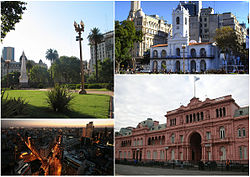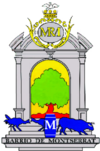Monserrat, Buenos Aires
| Monserrat | ||
|---|---|---|
| Barrio | ||

|
||
|
||
 Location of Montserrat within Buenos Aires |
||
| Country |
|
|
| Autonomous City | Buenos Aires | |
| Comuna | C1 | |
| Important sites |
City Hall City Legislature Buenos Aires Cabildo Café Tortoni Casa Rosada Colegio Nacional de Buenos Aires Jesuit Temple of St. Ignatius and college Plaza de Mayo Equestrian monument to General Manuel Belgrano |
|
| Area | ||
| • Total | 2.2 km2 (0.8 sq mi) | |
| Population | ||
| • Total | 43,560 | |
| • Density | 20,000/km2 (51,000/sq mi) | |
| Time zone | ART (UTC-3) | |
Monserrat (Spanish: [monseˈrat]) or Montserrat (in the original Catalan name, pronounced [munsəˈrat]) is a neighbourhood in the east of the Buenos Aires CBD. The district features some of the most important public buildings in Buenos Aires, including city hall, the city legislature, Casa Rosada, the Colegio Nacional de Buenos Aires and the Libertador Building (Ministry of Defense), among others.
Avenida de Mayo runs through the Monserrat district, connecting Plaza de Mayo and the Plaza de los Dos Congresos (Congressional Plaza).
A block, or two, south of the Plaza de Mayo, the older section of Monserrat begins. This is Buenos Aires' oldest neighborhood and even today, very little of the cityscape there is less than a hundred years old (except along Belgrano Avenue), thereby making a nearly seamless transition to the likewise historic San Telmo district, to the south.
The Monserrat area traces its origins to the foundation of Buenos Aires itself, when, in 1580, Spanish Adelantado Juan de Garay disembarked on the area's shores. The Fort of Juan Baltazar of Austria, the marginal settlement's first, was built in 1594 and, in 1608, newly arrived Jesuits were granted a 2-hectare (5 acre) lot, nearby. The Jesuits began work on the Saint Ignatius Church in 1686. Consecrated in 1734, it is the oldest existing church in Buenos Aires. Possessing the finest school and library at the time and offering colonial Buenos Aires' only truly classical education there, their property became popularly known as the "Illuminated Block." The small city's growing population led to the introduction of a number of other religious orders in this area, notably the Catalan Brotherhood of the Virgin of Montserrat, whose chapel became the neighborhood namesake in 1769. The Cabildo (City hall) became the scene of the 1810 pronouncements in favor of autonomy that later led to independence and, to commemorate the fact, in 1811 the iconic May Pyramid was placed in what later became the Plaza de Mayo.
...
Wikipedia

